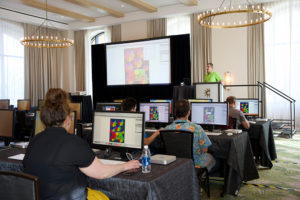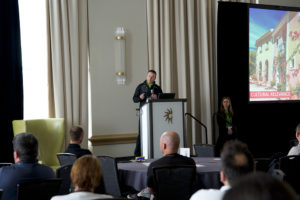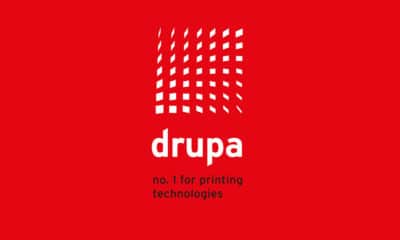HOSTED AT THE Gaylord Palms Resort & Convention Center in Orlando, Florida, the annual Eskoworld packaging software conference offered little about the kinds of sprawling display graphics typically featured in Big Picture. However, what Esko revealed about AI and data analytics at the May 23-25 event is likely to resonate with anyone who makes their business laying ink.
After all, printers of all stripes face the same headwinds. The world is increasingly digital, and e-commerce and omnichannel shopping are changing consumer behavior. “Sustainability” is no longer just a buzz word. Supply chain difficulties and talent shortages continue. Amid all these difficulties and more, “intelligent” software can help companies do more with less. The basic idea is to automate the mental gymnastics required to predict what will happen, adjust processes accordingly, and then optimize from there.
With products covering the entire packaging (and printing) workflow, Esko sees a competitive edge in providing the robust foundation of meaningful data required for this kind of automation. John Edison, the company’s new president, spoke of developing an “intelligent” data platform that “connects the dots” between these disparate software offerings – and, by extension, between job planning, production, and quality control.
However, the same principles are already at work on a smaller scale. Esko’s focus on packaging aside, examples demonstrated how AI (and software automation more generally) can make lower-quantity, higher-margin work – including wide-format work – more accessible and, by extension, more competitive. Perhaps the best example is a pre-press automation software for sheet layout, estimating, and planning.
Phoenix Rising
Designed for planning and imposition, Phoenix’s smart algorithms rely on a data foundation supplied by the user. Once that happens, however, the software can offer fast answers to a variety of critical questions. For example, what is the most efficient way to nest a piece of material for printing and cutting different jobs? Which sequence of presses and finishing equipment will yield the most cost-effective process? How will changing materials, presses, or any other aspect of the process affect the final quote?
The software does this by modeling the constraints of the job and of the user’s production environment. Based on these constraints, it essentially simulates the whole process and returns a list of increasingly cost-effective options. The longer the algorithm runs, the better the options become, and the less time and material the user wastes. One case study involved a conventional sheet plant that invested in digital wide-format printers to produce signs, custom boxes, and digital P-O-P displays. However, manual nesting and estimating processes made it difficult to scale up into more orders with many line items. With Phoenix, the company reportedly reduced daily layout work from three to four hours to one and pushed average daily jobs from 15 to 50, all without adding to headcount.
Advertisement
Engines of Automation
Representatives emphasized that Phoenix is easy to set up and use – the implication being there’s no need to be intimidated by AI. Messages about digitalization in general took a similar tone. In fact, the company announced a free version of Share & Approve, an online tool for viewing, annotating, approving, and otherwise communicating about design files. By offering this capability for free, even for non-customers, Esko hopes to encourage more stakeholders to embrace digitalization. The company has also been pushing software-as-a-subscription (SaaS) for its Automation Engine software suite. Compared to all-out purchasing, the subscription model can lower otherwise significant costs of entry, representatives claim.
Automation Engine is not new. In fact, these software tools have been helping PSPs – including some in the wide-format space – automate prepress operations for years. One example is the iCut Suite of prepress automation software designed specifically for sign makers. Included in this package is iCut Layout, a system that automatically nests material based on size, shape, and ordered quantities to minimize wasted time and materials. Creating and optimizing cut lines, adding bleed, and reducing prep time for large-format displays and substrates that require milling are other commonly automated functions among users of this system.
To whatever extent an individual company is ready or able to invest in prepress automation, Eskoworld highlighted the power of tools that are available now. The conference also provided ample evidence that the more these capabilities advance, the more barriers to meeting demand for faster turnarounds, lower volumes, and more personalized service will break down. In the wide-format space, where digital printers naturally lend themselves to ever-changing workflows, PSPs have reason to feel well-positioned for future challenges. However, manual tasks surrounding the print can still bog down production – a problem that any new competition in this space might not share.
Wide-format PSPs may feel well-positioned for future challenges, but digital printers that naturally lend themselves to ever-changing workflows may not be enough. Manual tasks surrounding the press can still bog down production – a problem that new competition is not likely to share. In short, the real “automation engine” in this industry is not enabling technology, but the people who chose to change their ways, even in the face of misgivings and uncertainty. To quote one anonymous Eskoworld attendee – a commercial printer that also dabbles in signs and displays – the choice is simple: “automate or die.”
PHOTO GALLERY (7 IMAGES)
 John Edison, president of Esko, gives a keynote address at the opening of Eskoworld 2023. The event attracted more than 500 packaging and label converters and brand representatives to Orlando for three days of education and networking.
John Edison, president of Esko, gives a keynote address at the opening of Eskoworld 2023. The event attracted more than 500 packaging and label converters and brand representatives to Orlando for three days of education and networking.

 Best of Wide Format2 months ago
Best of Wide Format2 months ago
 Best of Wide Format2 months ago
Best of Wide Format2 months ago
 Blue Print3 weeks ago
Blue Print3 weeks ago
 Best of Wide Format2 months ago
Best of Wide Format2 months ago
 Best of Wide Format2 months ago
Best of Wide Format2 months ago
 Best of Wide Format2 months ago
Best of Wide Format2 months ago
 Best of Wide Format2 months ago
Best of Wide Format2 months ago
 Best of Wide Format2 months ago
Best of Wide Format2 months ago



























